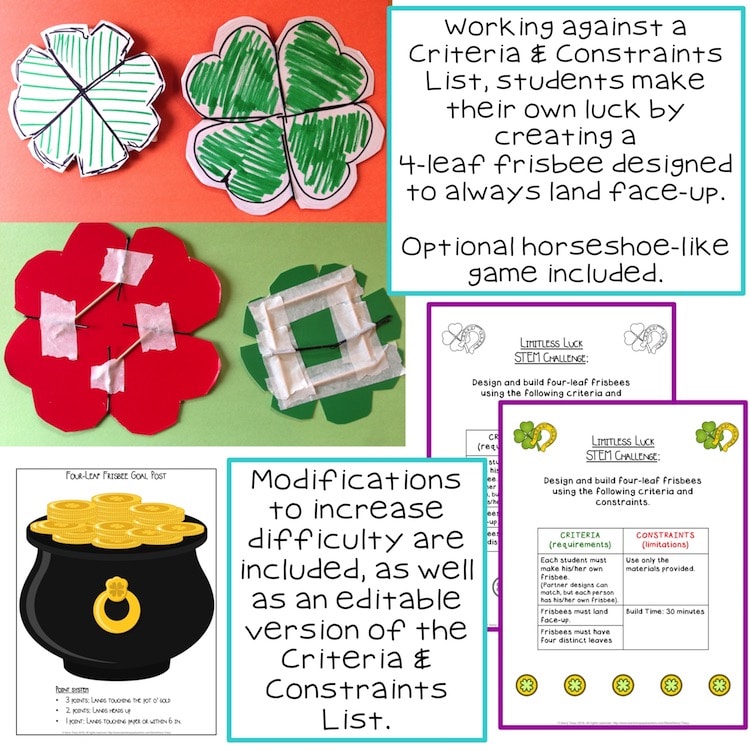Looking for St. Patrick’s Day activities that your students will love but are more than just a craft or activity to pass the time? This St. Patrick’s STEM Challenge (or STEAM Challenge) will keep your students engaged in brain-busting work disguised as fun!
The basic premise:
Pennies found face up, horseshoes, and four-leaf clovers have long been symbols of luck. This challenge combines an element of each famous symbol. Originally conceived as an introduction to probability, in this challenge, students “make” their own luck by creating a four-leaf frisbee designed to always land face-up. A horseshoe-like game called four-leaf frisbee was added as an extension for a little extra St. Patrick’s Day fun.
Working with a partner, students each design a four-leaf frisbee that will always land face-up. Students compare their results with a coin-flip test to measure the success of their designs.
In four-leaf frisbee, partner teams test their skill and luck in a game played similarly to horseshoes, receiving points when their four-leaf frisbee designs land on a pot of gold, heads up, or within 6 in. of the gold.
Design results are based on the heads-up probability of the frisbee design; it isn’t necessary to play the game, though it is a lot of fun!
Note: If you are in a 1:1 classroom, you may prefer the
digital format, compatible with Google Slides ™.
Resource includes:
- NGSS aligned standards, Grades 2 – 8
- Teacher Tips:
- Links to my 5-part video series on getting started with STEM challenges
- Materials and timing
- Criteria & Constraints (including modifications to increase difficulty for older students)
- Measuring results
- Universal STEM Challenge Notes & How to Use Student Handouts
- Post-design extension activities list
- Link to a video walk-through of the challenge
- Student Handouts:
- Criteria & Constraints List (in color and B&W; editable)
- Results and Design Analysis (2-page regular spacing and 4-page expanded) spacing for primary students included in color and and B&W; editable)
- Discussion Questions (color and B&W; editable)
- Extension templates
- Writing templates
- Simple probability practice (editable)
- Simple and compound probability practice (editable)
- Process Flow Map
- Math Extension
Sample/suggested materials for each student or group:
(Materials you’ll need to do the activity are easily modified.)
- Pot of Gold game marker handout (included) (1)
- Alternative: Use pots of “gold” (Gold chocolate coins, Almond Hershey’s Kisses or Rolos
- Paper plates (2 – 4)
- Bobby pins and/or paper clips (8 – 12)
- Tape (12 – 24 in.)
- Craft sticks (5 – 10)
- Toothpicks (10 – 20)
- Coin (1)
- Markers/crayons
- Ruler
- Scissors
- Data recording & design analysis handouts (included)
Optional:
- Pipe cleaners (1-2)
- Straws (3 – 5)
- Index cards (5 – 10)
Benefits of this STEM Design Challenge:
- Focus on critical thinking, problem solving, and application of learning
- Helps students develop growth mindset traits like persistence and resilience
- High levels of student engagement
- The potential to hit upon all NGSS ETS standards depending on the depth and number of iterations you choose to implement in your classroom (modifications included)
- Highly flexible and differentiated for materials, timing, grade levels, and rigor.
Each design iteration should be planned for ~60 min. if you are including data gathering and analysis rather than just building for fun. If you add extension activities, you will need to adjust timing accordingly.
This resource is also available in 1:1 Digital format, compatible with Google Slides (TM) as well as in discounted bundles.
If you prefer to purchase on TpT, click here.
Note: any coupon/promo codes for this site will only work on this site. TpT does not have the option for individual stores to offer promo codes.
Preview Music Credit:
“Carefree” Kevin MacLeod (incompetech.com)
Licensed under Creative Commons: By Attribution 3.0 License
http://creativecommons.org/licenses/by/3.0/















Reviews
There are no reviews yet.